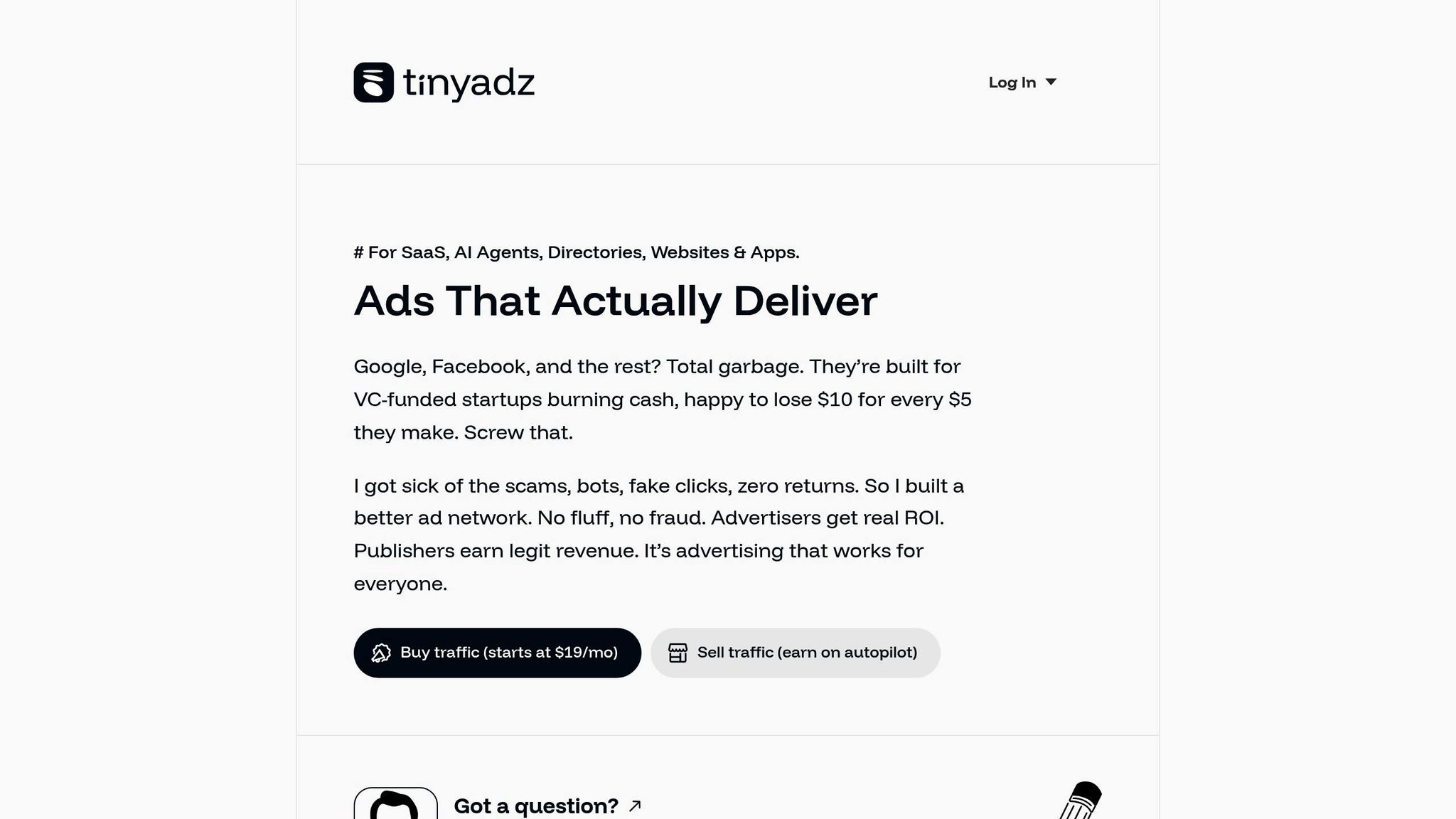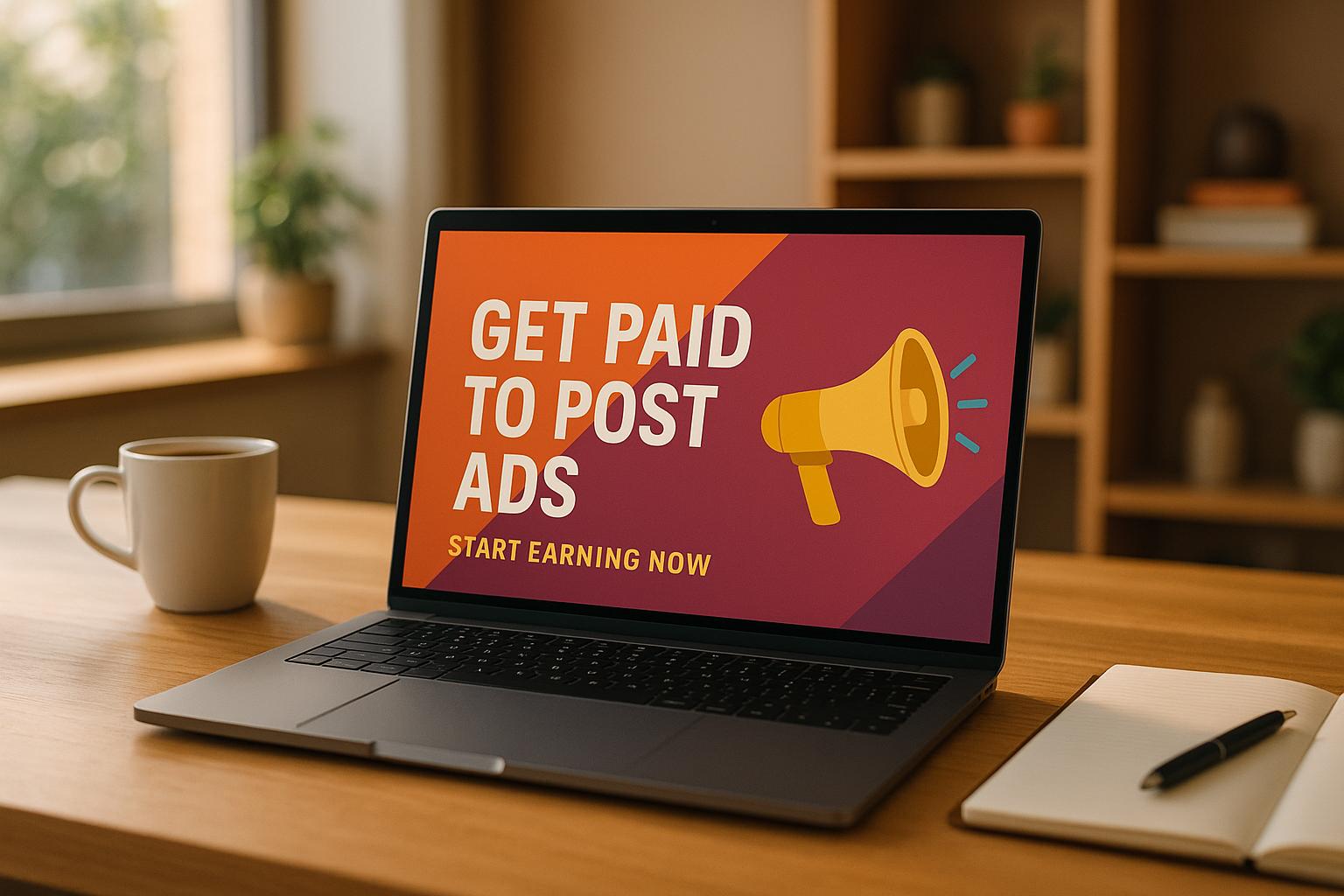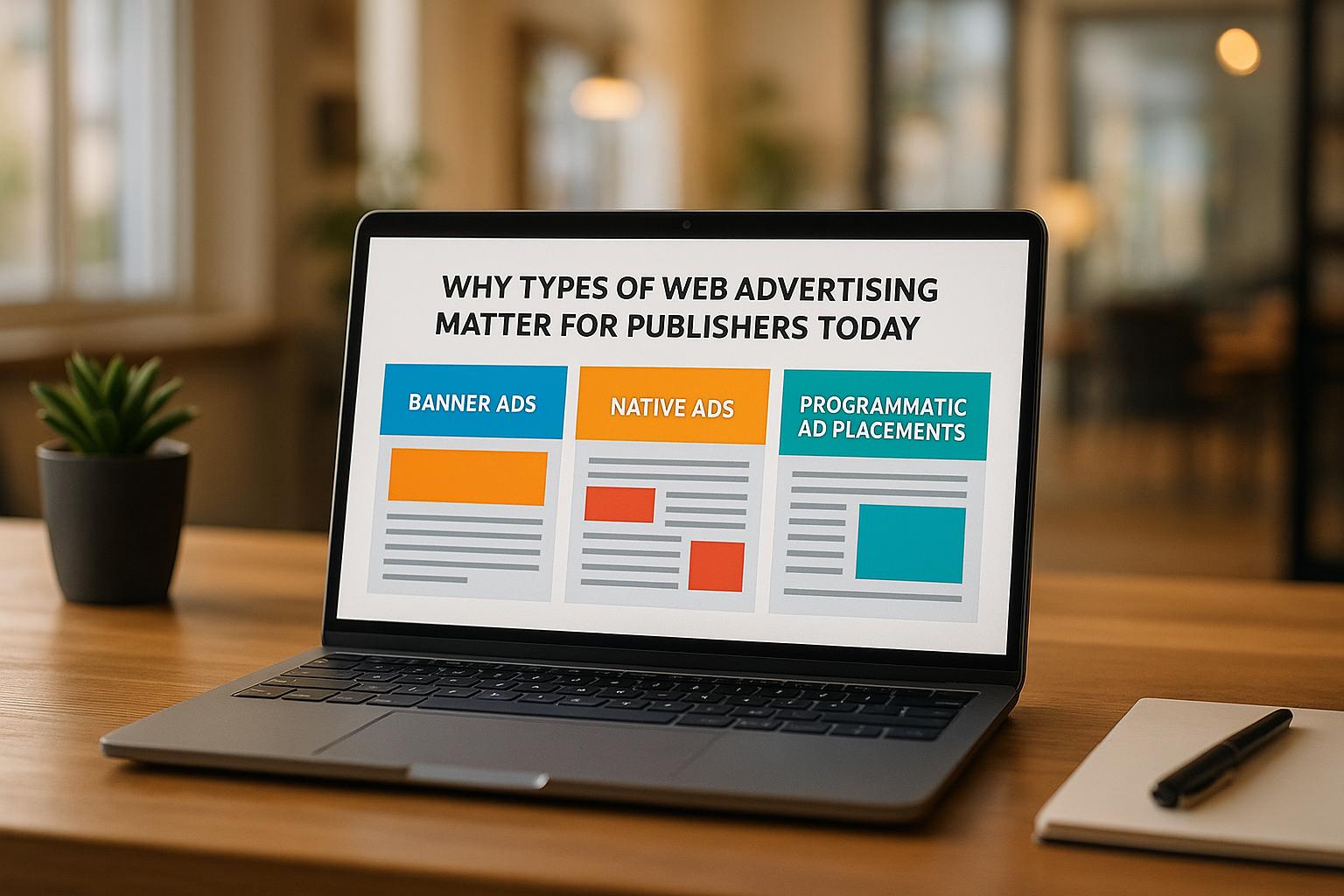Website ads can be a steady income stream - but how much can you actually make? Here's the quick answer:
- Traffic is key: Websites typically earn around $1 per 1,000 visitors, but this can scale up significantly. For example:
- 500,000 monthly pageviews: $1,000–$5,000 per month.
- 1 million monthly pageviews: $2,500–$25,000 per month.
- Ad pricing models: Revenue depends on Cost-Per-Mille (CPM), Cost-Per-Click (CPC), or Cost-Per-Action (CPA). CPM rates range from $2 to $10, depending on your audience's location and niche.
- Niche matters: Websites focused on specific topics (e.g., finance, tech) earn up to 35% more than general sites.
- Ad placement: Ads above the fold or within content perform best, but intrusive ads can hurt user experience and revenue.
Key takeaway: High-quality content, targeted audiences, and strategic ad placements drive ad revenue. Combine these with tools like Google Analytics or platforms like TinyAdz to optimize earnings.
Let’s break it down further with actionable steps and tools to maximize your website’s ad revenue potential.
How Much Ad Revenue Can a Website Make?
What Determines Your Website Ad Earnings
Your website's ad revenue isn't just about placing ads on your pages. Several factors come into play, shaping how much you can realistically earn. By understanding these elements - traffic, audience focus, and ad placement - you can set better goals and identify ways to improve your earnings.
Traffic Volume and Quality
The number of visitors to your site is important, but the quality of that traffic matters even more. For advertisers, a smaller, highly engaged audience is often more valuable than thousands of visitors who leave your site right away. Quality traffic means attracting people who match specific demographics, locations, and interests that advertisers are targeting. When your audience aligns with these criteria, you can charge higher rates and boost revenue.
Organic traffic from search engines tends to outperform social media traffic in terms of ad revenue. Visitors arriving through Google searches are often looking for specific information or solutions, making them more likely to click on ads or make purchases. In contrast, traffic from platforms like Facebook or Twitter may not have the same level of intent.
Your revenue model - whether it's CPM (cost per mille), CPC (cost per click), or CPA (cost per action) - also plays a role in determining whether you benefit more from high traffic volume or deeper audience engagement.
For example, in high-paying markets like the United States, RPM (revenue per thousand impressions) rates typically range from $2 to $10. Countries like the U.S., Canada, and the United Kingdom are often top markets where advertisers spend the most per person. To better understand your traffic and its potential, tools like Google Analytics can help you track metrics like volume, source, and user engagement.
Next, let’s look at how focusing on a specific audience niche can further enhance your ad revenue.
Audience Niche and Targeting
Niche websites consistently outperform general-topic sites when it comes to ad revenue. Advertisers are willing to pay up to 35% more for ad placements on niche sites because these platforms give them access to highly targeted, engaged audiences. By focusing on a particular topic or industry, you can attract a loyal community that advertisers value.
Niche websites also see significantly higher user engagement compared to general sites. Visitors spend 27% more time on specialized content, and these sites experience 53% more engagement overall. This level of interaction translates to better ad performance and higher revenue.
Beyond ad rates, niche sites also attract more sponsorships and enjoy higher affiliate conversion rates. They see 40% more sponsorship opportunities and 45% better performance on affiliate products tailored to their audience. Additionally, users of niche sites are more loyal, with 60% returning within a month because they trust the specialized content.
Certain niches, like finance and technology, command higher CPC and RPM rates due to advertiser demand. On the other hand, niches like entertainment may rely on larger audiences to generate revenue. As Feng Zhu, Assistant Professor at Harvard Business School, explains:
"Many companies are looking for variety and quality, not a lot of duplicate mainstream content." – Feng Zhu
Trust also plays a big role in niche success. About 67% of users trust niche sites for product recommendations, and 65% feel these sites offer more reliable information due to their specialized knowledge. This trust boosts ad performance and helps drive revenue.
Once you’ve built a targeted audience, optimizing where and how you place ads becomes essential.
Ad Placement and User Experience
Where you place your ads on your website can have a big impact on your earnings. The size, format, and location of ads all influence their visibility - and advertisers are willing to pay more for ads that users actually see.
Surprisingly, 54% of ad creatives go unseen by users, which means missed revenue opportunities. Strategic ad placement is a proven way to improve earnings, with nearly half of publishers prioritizing it. However, it’s crucial to balance revenue goals with user experience. If your ads are intrusive, you risk alienating your audience. For example, 32.8% of internet users use ad blockers, and 88% are less likely to return to a site after a poor ad experience. In fact, ad blocking could cost publishers up to $54 billion in lost revenue by 2024.
Generally, ads placed above the fold - where users don’t have to scroll to see them - perform better in terms of viewability and click-through rates. However, packing too many ads at the top of the page can harm user experience and may even reduce overall revenue.
To get the most out of your ad placements, consider these strategies:
- Use responsive ad formats to optimize for mobile users.
- Conduct A/B testing to find the best-performing ad locations without compromising user experience.
- Leverage tools like Google Analytics and heatmaps to analyze user behavior and refine your placements.
Other techniques, like sticky ads and lazy loading, can also improve ad performance. Sticky ads stay visible as users scroll, increasing viewability, while lazy loading speeds up your site by loading ads only when they’re about to appear on the screen.
Best Ad Monetization Methods for Website Owners
Once you understand the factors that influence ad earnings, the next step is to explore effective ways to monetize your site. By combining different strategies, you can diversify your income streams and maximize your revenue potential. Let’s dive into some of the best methods available.
Display Ads
Display ads are a cornerstone of online monetization. These include banners, sidebar ads, or other visual elements that typically operate under CPM (cost per thousand impressions) or CPC (cost per click) models. The rates you earn often depend on your niche and the quality of your audience.
The mobile ad market is a big player in this space. For example, by 2024, the mobile app market is expected to generate about $535 billion in revenue, with projections reaching $692 billion by 2027. Websites optimized for mobile stand to benefit greatly, especially since two-thirds of buyers now complete purchases on mobile devices.
Native Ads and Affiliate Marketing
Native ads blend seamlessly with your content, offering a less intrusive way to engage readers. Meanwhile, affiliate marketing allows you to earn commissions by promoting products or services that align with your audience’s interests. When visitors make purchases through your referral links, you get a cut of the sale.
While affiliate marketing requires more effort in creating relevant and engaging content, it often delivers higher earnings per visitor compared to standard display ads. Plus, it helps build trust with your audience, encouraging them to return to your site. Combining affiliate marketing with other strategies like direct ad placements can further enhance audience engagement.
Sponsored Content and Directory Listings
Sponsored content gives you the opportunity to partner directly with brands, creating tailored content that highlights their products or services. This approach allows you to stay true to your site’s voice while showcasing the brand’s message in a way that resonates with your audience.
Directory listings are another reliable income source, especially for local or niche websites. By featuring businesses on curated lists or resource pages, you can provide valuable resources to your audience while earning a steady income.
Platforms like TinyAdz make it easier to connect with advertisers for sponsored content and directory listings, helping you find brands that align with your audience’s interests.
sbb-itb-957fd63
Tools to Increase Your Ad Revenue
Once you've nailed down effective monetization strategies, the next step is finding the right tools to help you maximize your ad revenue. These tools can turn a modest income from your website into a reliable revenue stream. However, for small and medium-sized publishers, finding platforms that offer simplicity and value can be a challenge.
TinyAdz Monetization Solutions

TinyAdz offers a smart approach to monetization that goes beyond the typical banner ad setup. With options like directory listings, newsletters, and event monetization, the platform creates multiple revenue streams for publishers. This variety allows you to earn from various parts of your website, not just from ads.
What makes TinyAdz stand out is its focus on verified traffic and transparency. The platform ensures that advertisers get 100% human impressions, building trust and fostering stronger, long-term partnerships. This not only benefits advertisers but also boosts your credibility as a publisher.
Another highlight is the personalized matchmaking feature, which pairs you with advertisers that align with your audience. Instead of showing random ads that might irritate your visitors, you can display relevant content that your readers actually care about. This targeted approach often leads to better click-through rates and higher earnings per visitor.
TinyAdz also offers flexible ad formats, so you can choose campaigns that fit seamlessly into your site's layout. Whether you run a tech blog, a local directory, or a niche community site, you can find ad formats that enhance your content rather than detract from it.
"See how your ads or earnings are doing with easy-to-understand stats."
The platform's straightforward reporting system makes it easy to track how your ads are performing. You'll get clear insights into your earnings, top-performing ads, and areas for improvement. This level of transparency empowers you to make better decisions about your monetization strategies.
From here, it's essential to dive into performance metrics and analytics to refine your approach further.
Ad Performance and Reporting Tools
Tracking ad performance is just as important as choosing the right monetization methods. Key metrics like click-through rates (CTR), cost per thousand impressions (CPM), and earnings per visitor provide a clear picture of what’s working and what needs adjustment.
TinyAdz’s reporting dashboard gives you a detailed look at which ad formats and campaigns resonate most with your audience. By monitoring impressions, clicks, and earnings, you can quickly identify trends and opportunities. This data helps you decide where to place new ads or remove underperforming ones.
Regular analysis of your ad performance can uncover patterns in audience behavior. For instance, you might notice that ads embedded within your content perform better than those in the sidebar. Or perhaps certain topics drive more engagement and revenue. Use these insights to fine-tune your ad placements and focus on strategies that deliver results.
Seasonal trends are another area where reporting tools can make a big difference. Many websites experience fluctuations in ad revenue due to holidays, industry events, or seasonal interests. By tracking these trends, you can plan your content and ad placements to take advantage of peak earning periods.
The importance of advanced analytics tools is only growing. For example, Facebook Ads is projected to hit $200 billion in ad revenue by 2026, with AI-driven features like Advantage+ Shopping Campaigns potentially increasing returns on ad spend by 12%. This shows how crucial sophisticated reporting and optimization tools will be for publishers looking to stay competitive.
When analyzing your ad performance, focus on long-term patterns rather than daily ups and downs. A single day of low performance might not mean much, but consistent declines over weeks or months could signal a need for strategy adjustments. Use your reporting tools to spot these trends early, so you can make changes before they impact your revenue significantly.
Steps to Increase Your Website Ad Revenue
To boost your website's ad revenue, you need a mix of smart data analysis and strategic changes - all while keeping your audience's experience front and center.
Analyzing and Improving Ad Performance
Start by diving into your ad metrics with tools like Google Ad Manager (GAM). Run historical reports to evaluate how your ad units are performing. Pay special attention to metrics like creative size and device category - this can help pinpoint which formats resonate most with your audience. If you notice ad units with viewability rates below 50%, these are prime candidates for optimization.
A/B testing is a powerful way to refine ad placements. Test different positions - like mid-content, above or below images, or near navigation links - and measure how each placement impacts engagement.
"The concept of A/B testing is simple: show different variations of your website to different people and measure which variation is the most effective at turning them into customers." - Dan Siroker and Pete Koomen
Consider using flexible ad units that can accommodate multiple sizes. This encourages more competition among advertisers and can lead to better revenue outcomes. Tools like heatmaps are also invaluable - they reveal where users spend the most time on your site. Use this data to position ads in high-engagement areas. Additionally, take user behavior into account when scheduling ads, aligning them with time zones and peak activity periods.
Don’t overlook your site’s loading speed. According to Google, 53% of mobile visitors will abandon a page if it doesn't load within three seconds. After making changes, track key metrics like click-through rates, bounce rates, and time spent on the page to gauge the effectiveness of your adjustments.
"It's about being humble - let data guide every decision." - Dan Siroker
Once you've optimized performance, it's time to focus on compliance and building trust with your audience.
Following Regulations and Building User Trust
Adhering to regulations does more than just protect you from penalties - it also builds trust, which is crucial for long-term revenue growth. For example, staying compliant with the California Consumer Privacy Act (CCPA) ensures transparency by letting users opt out of data sales and requiring clear disclosures about data collection.
Implement a consent management platform (CMP) to streamline how you collect and manage user consent. Be upfront about your data practices - explain how you collect, use, and target ads. Internally, establish privacy policies and train your team to prevent potential issues. Regular audits of your privacy processes ensure you’re respecting consumer rights, making it simple for users to access, modify, or delete their data.
"Privacy-Led Marketing is built on informed consent, legal compliance, and welcoming users' preferences. Shape your digital strategy, protect your business, and make your customers happier." - Usercentrics
Finally, ensure all your ads are truthful and backed by evidence. Misleading claims can damage trust and hurt your reputation. With global digital ad spending projected to hit $835 billion by 2026, combining compliance with transparency is key to standing out in a competitive market.
Key Points for Website Monetization Success
Turning your website into a revenue generator takes a mix of smart ad placement, engaging content, and consistent performance tracking. Let’s break down the key elements that drive income.
Revenue potential is largely tied to your traffic. For instance, websites with monthly pageviews between 1.5 million and 10 million typically earn between $3,000 and $20,000. Those with 10 million to 50 million pageviews can see earnings of $20,000 to $100,000, while sites hitting 50 million to 100 million pageviews may bring in $100,000 to $500,000 per month.
Ad formats also play a big role. Google AdSense, for example, generally earns $0.20 to $2.50 per 1,000 views. However, using header bidding can increase revenue by 35% to 65% compared to AdSense alone. Video ads, which tend to have higher CPMs, are another effective way to boost income.
Geographic targeting adds another layer to your strategy. AdSense performance varies by region, with the United States leading in click-through rates (CTR) at 0.75% and a cost-per-click (CPC) of $0.61. Meanwhile, Luxembourg offers the highest CPC at $0.65, despite a slightly lower CTR of 0.55%. Knowing these regional trends can help you refine your audience targeting for better results.
Successful monetization often involves diversifying income streams. Instead of relying solely on display ads, many publishers mix in affiliate marketing, sponsored content, and premium memberships. This approach helps cushion against market shifts and fluctuations in any one revenue source.
Fast-loading pages and well-placed, non-intrusive ads are essential to keep users engaged - and your revenue steady. Slow sites or annoying ad placements can drive visitors away and hurt your bottom line.
Specialized tools like TinyAdz can simplify this process. They offer transparent analytics and advanced ad management without requiring a minimum traffic threshold. These tools also provide protection against ad fraud, a major issue that cost the global advertising industry $35 billion in 2020 and is projected to hit $50 billion by 2025.
FAQs
What is the best ad pricing model to maximize revenue for my website?
The right ad pricing model for your website hinges on factors like your traffic levels, audience habits, and revenue objectives. CPM (Cost Per Mille) is a solid choice for sites with high traffic aiming to boost brand visibility. With CPM, you earn a fixed amount per 1,000 impressions - usually between $3 and $5. On the other hand, CPC (Cost Per Click) suits goals centered on driving conversions. CPC rates typically range from $0.02 to $0.50 per click, depending on the niche and competition.
To zero in on the most profitable model, take the time to analyze how your audience interacts with your site. Experiment with different pricing models and keep a close eye on performance metrics. Over time, this strategy will help you determine which approach aligns best with your website’s goals.
How can I improve my website traffic to earn more from ads?
To drive more traffic to your website and boost ad revenue, the key is attracting engaged, high-quality visitors who genuinely connect with your content. Start by crafting content that directly addresses the interests and needs of your audience. Make sure it's tailored, relevant, and provides real value.
Next, focus on search engine optimization (SEO) to improve your site's visibility and bring in organic traffic. This means using the right keywords, optimizing meta descriptions, and ensuring your content answers the questions people are searching for.
A great user experience is non-negotiable. Ensure your site loads quickly, is easy to navigate, and works seamlessly on mobile devices. These factors not only keep visitors on your site longer but also encourage them to return.
Promoting your content is just as important as creating it. Use social media, email campaigns, and even partnerships with influencers to get in front of the right audience. Look at your traffic data to identify the most effective channels and double down on those that bring in the most engaged users.
By focusing on quality over sheer numbers, you can attract visitors who are more likely to interact with your site, increasing both your traffic and ad revenue opportunities.
How can I optimize ad placement to boost revenue without disrupting the user experience?
To get the most out of ad placement without disrupting the user experience, it’s all about smart positioning. Ads should catch the eye but not interrupt the natural flow of your content. For desktop users, sidebars work well, while mobile users often respond better to ads placed at the top or bottom of the page. Formats like native ads - which blend naturally into your content - or rewarded ads, offering users something in return, are great options.
Keep in mind, less is more when it comes to the number of ads. A good rule of thumb is sticking to 3–4 per page to avoid overwhelming your visitors. And don’t forget about relevance - ads that align with your audience’s interests are far more likely to engage them while reducing frustration. Use your site analytics regularly to track how users interact with your ads and adjust placements to strike the perfect balance between boosting revenue and keeping your audience happy.


